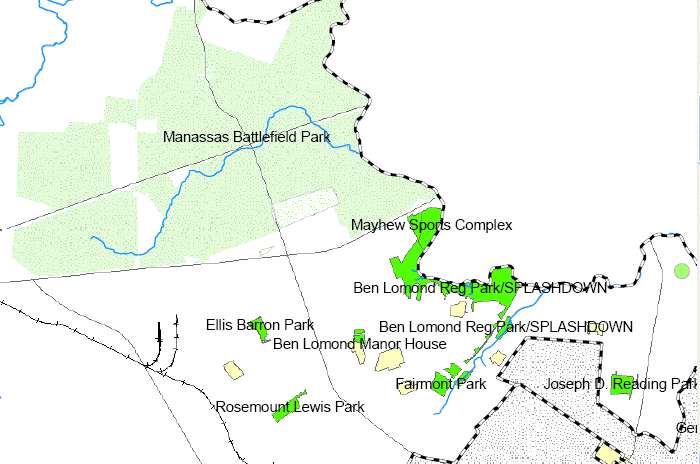
Parks and Open Space in Prince William, 2003
Source: Prince William County 2003 Comprehensive Plan
Today, counties and cities create Comprehensive Plans that envision the future, 20-25 years from now... and then update the plans every 5 years or so. The Comprehensive Plans are intended to shape development over time to implement the vision in the plan.
For example, the 2003 Comprehensive Plan for Prince William County "seeks to ensure a high quality of life for all County residents and heighten the County's image by:
. Providing large amounts of open space, particularly in preservation and conservation areas,
. Encouraging higher land use densities at transit locations,
. Maintaining planned levels of residential and non-residential development,
. Providing adequate and affordable public services to meet the needs of current and future residents, and meeting established levels of service,
. Improving the design of sites and buildings.
Plans are organized different ways in different jurisdictions, but the list of chapters in the 2003 Prince William County Comprehensive Plan illustrates the level of detail in the documents:
. Community Design
. Cultural Resources
. Economic Development
. Environment
. Fire and Rescue
. Housing
. Libraries
. Long-Range Land Use (with 19 land use categories)
. Parks and Open Space
. Potable Water
. Schools
. Sewers
. Telecommunications
. Transportation
That Comprehensive Plan also contains a series of sector plans for specific areas, and divided the County into a Development Area and a Rural Area (also known as the Rural Crescent).
In theory, county approvals of rezonings, site plans, and special use permits - plus county investments in infrastructure such as schools and roads - would be steered by the goals, policies, and action strategies in each of the chapters. Over the long run, those site-specific decisions would transform the county, moving it towards the vision in the plan. However, the guidance in the comp plan is optional. Country staff, Planning Commissions,, and supervisors can ignore it.
Zoning is significantly different - it is mandatory, unless specifically waived. As a result, rezonings are often more contentious than re-plannings, because a rezoning is requested only when a developer has short-term plans to implement the change. The Zoning Map defines specific uses allowed, and not allowed, in a particular location. "Zoning approval is required prior to the construction of any new structure and the commencement of any new use on a property," as noted by Prince William County.1
The purpose of the Zoning Ordinance in Fairfax is lengthy, but if you want to have a say in how your neighbor's property is developed (including what signs can be erected), you need to understand the document:2
|
The Zoning Ordinance of Fairfax County, Virginia, is intended to promote the health, safety and general welfare of the public and to implement the adopted comprehensive plan for the orderly and
controlled development of the County. To accomplish these ends, the Zoning Ordinance is designed to give reasonable consideration to each of the following purposes, where applicable: 1. to create and maintain conditions under which people and their environment can exist in a productive and enjoyable harmony while fulfilling the social, economic and other requirements of present and future generations; 2. to facilitate the creation of a convenient, attractive and harmonious community; to provide for adequate light, air, convenience of access and safety from fire, flood, crime and other dangers; and to reduce or prevent congestion in the public streets; 3. to provide for County growth that is consonant with the efficient and economic use of public funds and environmental quality; 4. to recognize the needs of agriculture, housing, industry and business in the County's future growth; 5. to promote the creation and expansion of land uses that will be developed with adequate highway, utility, health, education and recreational facilities; 6. to provide residential areas with healthy surroundings for family life; 7. to protect against destruction of or encroachment upon historic areas; 8. to encourage economic development activities that provide desirable employment and a broad tax base; 9. to promote the conservation of natural resources; 10. to encourage the preservation of stream valleys, steep slopes, lands of natural beauty, dense forestation, scenic vistas, and other similar areas and to ensure that development in such areas is well controlled; 11. to protect against the following: overcrowding of land; undue intensity of noise; air and water pollution; undue density of population in relation to community facilities existing or available; obstruction of light and air; danger and congestion in travel and transportation; and loss of life, health, or property from fire, flood, panic or other dangers; 12. to promote the creation and preservation of housing of such type, size and cost suitable for meeting the current and future needs of the County as well as a reasonable proportion of the current and future needs of the planning district in the form of safe, sanitary dwelling units; 13. to encourage innovative and desirable approaches to designed development; and to promote the distinctive sense of urban, suburban and exurban places as well as the sense of community within the County; 14. to protect, not inconsistent with State water quality standards, surface water and ground water as defined by Sect. 62.1-255 of the Code of Virginia; 15. to accomplish all other objectives and exercise all other powers set forth in Article 7, Chapter 22, Title 15.2 of the Code of Virginia. |